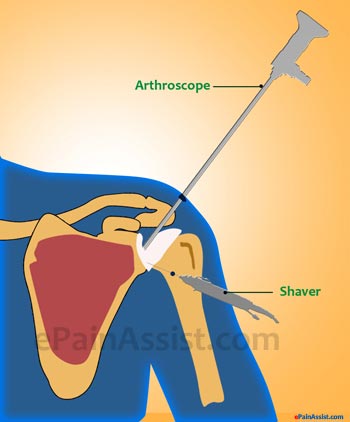Rest
Shoulder joint rest is achieved by using arm sling or shoulder braces. Rest prevents shoulder joint movements and thus prevents initiation of pain. Rest is advised until inflammation is healed in almost all diseases causing shoulder joint pain.
Cold Compression Therapy
Cold compression therapy is provided by applying ice bag over shoulder joint. Ice prevents joint swelling and bleeding. Ice almost reduces pain.
Heat Compression Therapy
Heat therapy helps to improve blood circulation and is avoided if shoulder joint bleeding is associated with pain. Heat treatment is helpful to treat pain caused by joint sprain or arthritis. Heat therapy is also advised for pain observed following surgery.
RICE Therapy
RICE therapy is a combination therapy, which includes rest, ice, compression and elevation of the joint (RICE- Rest, Ice, Compression and Elevation).
Conservative Treatment For Shoulder Joint Pain Is Indicated For Following Diseases-
- Tendonitis
- Shoulder Joint Sprain
- Shoulder Joint Arthritis
- Following Close Reduction
- Following Surgery
Medications Prescribed For Shoulder Joint Pain
NSAIDs (Non Steroidal Anti-Inflammatory Medications) For Shoulder Joint Pain:
Indications for anti-inflammatory medication are inflammatory diseases and chronic shoulder pain caused by inflammation.
Following Inflammatory Diseases Can Cause Shoulder Joint Pain:
- Arthritis– Osteoarthritis, Rheumatoid Arthritis.
- Tendonitis
- Bursitis
Opioids For Shoulder Joint Pain:
Opioids are also known narcotics. Opioids are prescribed for chronic shoulder joint pain of all type including nociceptive and neuropathic pain.
Short acting opioids are prescribed for mild to moderate shoulder pain or breakthrough severe pain of shoulder joint.
Following opioids are most commonly prescribed for chronic shoulder pain.
- Short Acting Opioids For Shoulder Joint Pain-
- Hydrocodone- Vicodin, Lortab and Norco
- Oxycodone- Oxy IR and Percocet
- Morphine- MS IR and Morphine Sulphate
- Long Acting Opioids For Shoulder Joint Pain-
- Oxycodone- Oxycontin
- Morphine- MS Contin
- Methadone
- Fentanyl Patch
Antiepileptic Analgesics For Shoulder Joint Pain
Neuropathic pain resistant to NSAIDs or opioids are often treated with antiepileptic analgesics such as Lyrica and Neurontin.
Antidepressant analgesics For Shoulder Joint Pain
Antidepressants are used to treat neuropathic pain. Anti-depressants prescribed for neuropathic pain are Elavil and Lyrica.
Physical Therapy (PT) To Treat Shoulder Joint Pain
Indications For Physical Therapy (PT) Is As Follows-
- Strengthening of Shoulder Muscles
- Improve Flexibility of the Shoulder.
Physical Therapy Is Advised For Following Diseases Causing Shoulder Pain-
- Frozen Shoulder 1
- Post Surgery
- Shoulder Joint Tendonitis
- Shoulder Joint Bursitis
- Shoulder Joint Arthritis
Interventional Therapy
Corticosteroid Injection of Shoulder Joint-
Procedure is performed under local anesthesia. Following shoulder joint diseases are treated with corticosteroid injections-
- Shoulder Joint Tendonitis.
- Shoulder Joint Bursitis.
- Shoulder Joint Arthritis.
Nerve Block-
Severe pain is occasionally treated with brachial plexus block. Following diseases of the shoulder joint are treated with brachial plexus block.
- Neuropathic Pain Caused By Surgery
- Pain Associated With Tingling, Numbness And Weakness In Shoulder Joint
- Shoulder Joint Stiffness
Cervical Epidural Injection
Diagnostic and therapeutic cervical epidural steroid injection is performed to treat chronic shoulder joint pain caused by pinch nerve in the cervical dermatome.
Surgery To Treat Shoulder Joint Pain
Shoulder Joint Arthroscopy

Surgery is performed under local or general anesthesia. Arthroscope (endoscope) is inserted into shoulder joint and shoulder joint examination is performed under direct vision using camera of the arthroscope.
Following Diseases Are Treated With Arthroscopy-
- Removal of loose cartilages causing pain in osteoarthritis.
- Removal of inflammatory soft tissue in patients suffering with osteoarthritis and rheumatoid arthritis.
- Repair of tendon or ligamental tear.
- Removal of disease and worn out cartilage fragments.
Close Shoulder Joint Reduction
Procedure is performed under deep sedation or general anesthesia. Indication for close shoulder reduction-
- Shoulder Joint Subluxation
- Shoulder Joint Dislocation
- Shoulder Joint Fracture
Open Shoulder Joint Reduction
Indication For Close Shoulder Reduction-
- Shoulder Joint Subluxation
- Shoulder Joint Dislocation
- Shoulder Joint Fracture
Tendon Repair
- Complete tear of tendon is repaired by open surgery.
- Partial tear of tendon is repaired following arthroscopy or open surgery.
Rotator Cuff Repair
- Rotator cuff tear is repaired following arthroscopy.
- Rotator cuff tear surgery if fails to relieve pain following arthroscopy surgery then repair is performed with open surgery.
- Rotator cuff tear associated with dislocation or fracture of shoulder joint is treated with open surgery.
Reverse Shoulder Arthroplasty 2
This is a recent advanced surgery mostly performed for rotator cuff pain. Surgery improves the mobility and decreases pain.
Also Read:
References:
- The effectiveness of physiotherapeutic interventions in treatment of frozen shoulder/adhesive capsulitis: A systematic review.
Jain TK, Sharma NK.
J Back Musculoskelet Rehabil. 2013 Nov 27.
Department of Physical Therapy and Rehabilitation Science, University of Kansas Medical Center, Kansas City, KS, USA.
- Reverse shoulder arthroplasty.
Jarrett CD, Brown BT, Schmidt CC.
Orthop Clin North Am. 2013 Jul;44(3):389-408, x. doi: 10.1016/j.ocl.2013.03.010.
Upper Extremity Reconstructive Surgery, The Emory Orthopaedic Center, Emory University School of Medicine, 59 Executive Park South, Suite 2000, Atlanta, GA 30329, USA.

